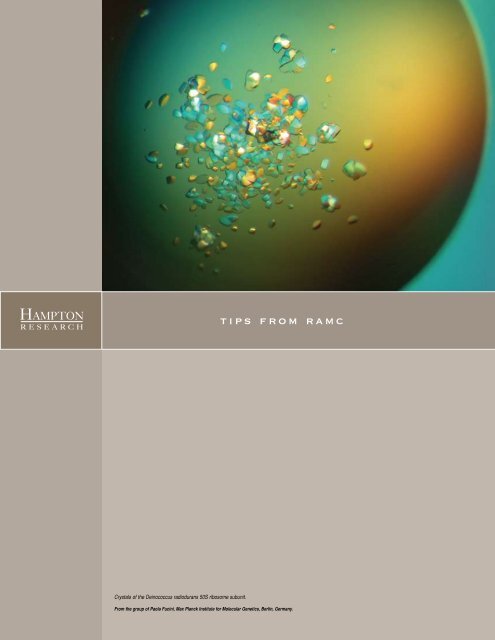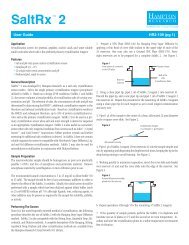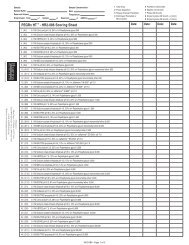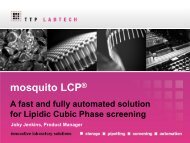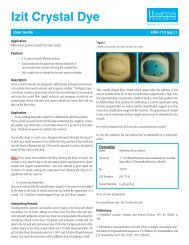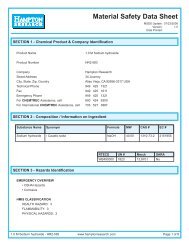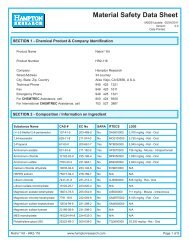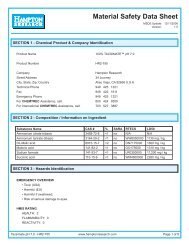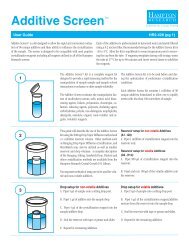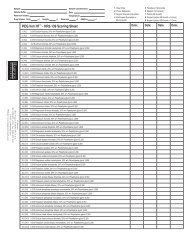tips from ramc - Hampton Research
tips from ramc - Hampton Research
tips from ramc - Hampton Research
Create successful ePaper yourself
Turn your PDF publications into a flip-book with our unique Google optimized e-Paper software.
<strong>tips</strong> <strong>from</strong> <strong>ramc</strong><br />
Crystals of the Deinococcus radiodurans 50S ribosome subunit.<br />
From the group of Paola Fucini, Max Planck Institute for Molecular Genetics, Berlin, Germany.
<strong>tips</strong> <strong>from</strong> <strong>ramc</strong><br />
Tips <strong>from</strong> Recent Advances in Macromolecular Crystallization Meetings<br />
Page 1-7<br />
Filtering the Protein<br />
Naomi Chayen<br />
To reduce the number of crystals and increase their size, try filtering the protein<br />
solution prior to setting up the experiment. Try the following filter sizes: 0.22,<br />
0.1 micron and 300 kD molecular weight cut-off. Try the Millipore centrifugal<br />
filters.<br />
Pseudo-Microseeding<br />
Mike Sintchak<br />
When working with crystals that grow fairly rapidly (one day) try the following.<br />
Pipette multiple protein drops (2 to 4 works best) onto the cover slide. Using<br />
a single pipette tip, get the reservoir solution to mix with the first drop. Now,<br />
go back into the reservoir with the same tip to get the reservoir solution for the<br />
second drop. Continue for the remaining drops with the same tip. In certain<br />
cases, seeding starts very quickly, so by using the same tip one can introduce<br />
minute seeds to successive drops. Use the same cover slide with multiple drops<br />
to minimize evaporation.<br />
precipitant solution. Large, gorgeous crystals were produced when I crossed the<br />
drop, creating a gradient within the drop. This worked best, setting up sitting<br />
drops with vapor diffusion.<br />
Don’t Flip<br />
Dennise Dombroski<br />
When removing crystals <strong>from</strong> a hanging drop, I sometimes find that the biggest<br />
crystals fall against the coverslip and are impossible to resuspend without damage.<br />
I had our glass shop make a stand to transfer the coverslip that enabled me<br />
to manipulate the crystals more easily.<br />
Low Molecular Weight PEGs<br />
Lesley Haire<br />
When screening with low molecular weight PEGs try microbatch. Crystals appear<br />
rapidly with PEG 400-2000. To convert to vapor diffusion use 0.2 M buffer in the<br />
well and a 1:1 drop ratio. Try using a positive displacement pipette such as the<br />
Anachem Microman 1 - 10 µl. These are much more accurate.<br />
Purest is Not the Best<br />
Michal Harel<br />
A protein which was purified and showed some faint bands of contaminants on a<br />
native gel was crystallized and solved successfully. The same protein, purified by<br />
HPLC and resulting in a single band native gel did not crystallize.<br />
Cryoprotectant<br />
Elspeth Garman<br />
When making up cryoprotectant solutions containing glycerol, put a test tube of<br />
glycerol in a beaker of warm water. The viscosity falls and it is easier to pipette<br />
accurately.<br />
Mass spectrometry<br />
David Leys<br />
We found mass spectrometry like ESMS and MALDI highly efficient in determining<br />
impurities and/or microheterogeneities in our protein sample/batch. In most<br />
cases it is a simple, straight forward method which requires a minimum amount<br />
of sample. In some cases it has shown to detect impurities/microheterogeneities<br />
when other techniques did not.<br />
Shape of Drop<br />
Ursula Kamlott, Hoffmann-La Roche: ursula.kammlott@roche.com<br />
One of my proteins produced only zillions of tiny useless crystals when I mixed<br />
the drops the conventional way-mixing well, overlaying, etc. the protein with<br />
Extreme Soak<br />
Jirundon Yuvaniyama<br />
For soaking crystals with compounds with limited solubility I have tried two<br />
“extreme ways” (although not much- and more experiments should be tried):<br />
• Leave some solid compound in the soaking solution.<br />
• Dissolve some compound in n-octanol and layer the octanol solution on top<br />
of the soaking experiment.<br />
These two provide (hopefully) more or less constant concentration of the compound<br />
in the soaking solution. The octanol layer may help reduce air oxidation<br />
by preventing direct contact of soaking solution to air.<br />
I found that 200 µl of soaking solution in a well of the 24 well Linbro ® plate is a<br />
good volume to work with:<br />
—Not too little that possibly causes concentration change due to evaporation<br />
(Sealed well) and not too much that the crystals get lost in the solution.<br />
The Glycerol Effect<br />
Anil Mistry<br />
Glycerol has many benefits but also some drawbacks. We found it to be beneficial<br />
with one protein we were working with; this protein is a transpeptidase called Mur<br />
A. The protein is quite soluble and could concentrate to 20 mg/ml but it lost activity<br />
over time when stored at 80°C. We therefore dialysed it into 50% v/v Glycerol to<br />
see if the activity could be retained for longer, this would allow us to make a large<br />
batch rather than regular smaller batches, for crystallisation. On dialysis we found<br />
a significant reduction in the volume of protein, so much so that the protein had<br />
concentrated <strong>from</strong> 5-10 mg/ml to almost 50 mg/ml. Activity was also found to be<br />
retained with no significant loss after 6 months at 80°C. This gave us a method for<br />
storing large batches of Mur A at 80°C, without losing activity and also resulted<br />
in a sample pre-concentrated for crystallisation and containing a cryo-protectant.<br />
Other sugars gave similar effects; sucrose, sorbitol, etc., but none were as effective<br />
as glycerol in achieving the 50 mg/ml final concentration.<br />
<strong>tips</strong> <strong>from</strong> <strong>ramc</strong><br />
251
<strong>tips</strong> <strong>from</strong> <strong>ramc</strong><br />
Page 2-7<br />
Iodoacetic Acid<br />
Bernie Santarsiero<br />
Add a small amount of (~ 1%) iodoacetic acid to buffer solutions. This helps<br />
prevent aggregation by carboxymethylation of cys. Also, iodoacetic acid seems<br />
to help form salt bridges and aid in crystallization.<br />
Soaking Crystals to Improve Resolution<br />
Irene Weber<br />
Try soaking poorly diffracting crystals in higher concentration of precipitate,<br />
ammonium sulfate, or PEG. It may take several weeks so test after 1 or 2<br />
months.<br />
Rapid Preliminary Screening of Protein for Aggregation Using Protein<br />
Quantities<br />
Tom Zarembinski<br />
When only small amounts of protein are available, it is not feasible to screen<br />
many compounds which promote monodispersim using a dynamic light scattering<br />
machine. To detect aggregation, we use a pseudo-native gel approach: 1<br />
l of protein is mixed with 1 l of additive <strong>from</strong> <strong>Hampton</strong> Additive or Detergent<br />
Screens. These samples are then incubated at room temperature for 20-30 minutes<br />
and then placed in 2x sample buffer containing no DTT, no SDS and are not<br />
boiled. These samples are run on a standard SDS-PAGE gel. We have screened<br />
many additives using this approach and it has given us leads for subsequent<br />
optimization of protein buffers.<br />
only for the drops thus using a few µl per experiment rather than O.5 ml. Saves<br />
having a 48 well screening solution set with one tube empty and the rest at 8 ml<br />
and still allows the superstitions or in Alex’s case, the contaminated solution to<br />
reproduce crystals.<br />
Recycle Your Precipitate<br />
Neali Armstrong<br />
If your protein refolding reaction has a low yield and produces lots of precipitate<br />
try collecting the precipitate, resolubilize in GuHCl, and refold again. This material<br />
is sometimes more pure than the washed inclusion bodies.<br />
90% Solutions<br />
Anna Stevens<br />
When optimizing or making solutions for a random scan, omit the buffer (@<br />
final O.1 M) so that your stock is 90%. Prior to putting your stock in the well, add<br />
100 µl of 1M buffer of your choice. Next, add 900 µl of 90% stock and mix. This<br />
reduces the number of tubes for crystallization (precipitant) stocks and allows<br />
flexibility in buffer identity and pH range. Be sure to make plenty of (~20 mL) of<br />
precipitant, you’ll need 900 µl per buffer.<br />
Check Both Liquid Nitrogen + Stream Flash Cooling<br />
Hans Parge<br />
If your crystal does not freeze well in the cold stream try liquid nitrogen or vice<br />
versa.<br />
<strong>tips</strong> <strong>from</strong> <strong>ramc</strong><br />
HPLC Profile<br />
Glenn Dale<br />
Keep an HPLC (Reverse phase) profile of your protein before crystallisation and<br />
after crystal formation. It can be used as a quality control and tells you if any<br />
modifications have occurred.<br />
Don’t Throw Away Without Looking Close<br />
Kalevi Visuri<br />
Look closely at your old test tubes when cleaning the place. Proteins do crystallize<br />
on the walls of the tube when stored in a cold room. I picked up my tubes <strong>from</strong> the<br />
wastebasket and an x-ray was made <strong>from</strong> an old supersaturated protein tube.<br />
Concentration of Protein without Aggregation<br />
Paul Reichert<br />
Use centipreps (millipore) for concentrating protein >O.5 ml. Protein concentrating<br />
away <strong>from</strong> membrane. (No micro high concentration, ppt on membrane),<br />
works very nicely for a number of proteins.<br />
Preserve <strong>Hampton</strong> Solutions<br />
Cheryl Janson<br />
To preserve <strong>Hampton</strong> solution when you or a co-worker gets a “hit” and suspect<br />
the <strong>Hampton</strong> solution may be “magic” or you cannot reproduce crystals with<br />
lab-made solution, make the reservoir solution <strong>from</strong> lab ingredients and use<br />
your homemade solution for reservoirs. Use the <strong>Hampton</strong> “magic” solution<br />
To Determine the Optimal Concentration of Your Protein for<br />
Screen I and Screen II<br />
Jaru Jancarik<br />
Try (setup) drop no. 6 first (of Screen I). It should produce light precipitation if<br />
ppt appears too heavy, reduce the protein concentration by 1/2 and try again. If<br />
there is no precipitation in drop 6 try drop 4. If there is no precipitation in either<br />
of the drops concentrate the protein 2 fold and try again.<br />
Cryoprotectant Additive<br />
Laura Pelletier<br />
I tried adding 1-10 mg/ml BSA in the cryoprotectant when soaking crystals that<br />
would crack. The one time it was used, the crystal did not crack and froze nicely.<br />
I don’t know if the BSA was the reason for successful freezing. I was wondering<br />
if anyone else has tried this.<br />
Slow Cryosoaks for Improved Crystal Stability<br />
Bryan Prince & Melissa Harris<br />
In a sitting drop well, cryoprotectant (20% Glycerol in crystallization buffer) should<br />
be dribbled down the side of the well.<br />
Crosslinking of Crystals<br />
Clare Stevenson<br />
When crystals are fragile or you want to transfer them to a different mother<br />
liquor e.g. for heavy atom soaking, why not try crosslinking your crystals with<br />
252 <strong>Hampton</strong> <strong>Research</strong> • Phone: 800-452-3899 or 949-425-1321 • Fax: 949-425-1611 • www.hamptonresearch.com • Customer Service: info@hrmail.com • Technical Support: tech@hrmail.com
Solutions for Crystal Growth<br />
Page 3-7<br />
0.1% glutaraldehyde in your mother liquor. This can be done by adding the<br />
glutaraldehyde directly to the drop or placing it next to the drop and allowing<br />
for vapour diffusion. This crosslinking enabled us to solve Mod A at 1.2 A resolution.<br />
Know When Enough is Enough!<br />
Brent Segelke<br />
As a graduate student, I spent countless hours and quantities of protein trying<br />
to get crystals of a single construct. We never got crystals. Another group got<br />
the structure of a homologous protein that was auto-digestive. Had we stopped<br />
after 400 trials and altered our construct, perhaps we would have faired better,<br />
we couldn’t have faired any worse. There is a reasonable statistical argument to<br />
demonstrate that 400 trials are a good limit.<br />
Buffer Screening<br />
Anil Mistry<br />
To find the best buffer system which will keep your protein happy, stable, and<br />
soluble for concentration prior to crystallisation, setup your protein (at 1-2 mg/<br />
ml) in hanging drops over 1 ml well solutions containing a series of buffers at various<br />
pHs, with various additives/stabilizers, etc. (but no precipitant!). Checking<br />
for drops which are clear will give an idea of which solutions keep the protein<br />
happy. In addition, as the system attains equilibrium some in situ concentration<br />
of protein will be induced due to the bulk difference between the drop and<br />
well volumes, hence an idea of how the protein behaves upon concentration<br />
in this solution will also be observed. Modifying a clear or slightly clear drop by<br />
adding a higher concentration of buffer to the well may even produce crystals.<br />
However, the main piece of information this method can produce is an idea of<br />
which buffer system and additives to put your protein into prior to concentration<br />
a crystallisation screening.<br />
Cross Seeding to Generate Crystals of a Related Protein or Protein/<br />
Inhibitor Complex<br />
Margaret O’Gara<br />
If your protein or protein complex fails to crystallize try seeding <strong>from</strong> crystals of the<br />
same protein (if it’s a protein you want to crystallize) or a related protein for apo<br />
protein crystals. Serial micro seeding works best, make sure you look at the drops<br />
after seeding to identify any visible crystal seeds in there (i.e. not new crystals).<br />
Advice for the Follically - Challenged Crystallographer<br />
Jonathon Hadden<br />
It has been long accepted that crystallizers with an abundance of facial hair<br />
have highly successful careers (Leeds University personal observation). This was<br />
thought to stem <strong>from</strong> the fact that matter found its way <strong>from</strong> the hair into the<br />
trials and acted as a nucleation centre-BUT SERIOUSLY; Addition of small grains<br />
of sand to a crystallization drop that is “close to producing” crystals can aid in<br />
nucleation and crystal growth.<br />
Raise the DMSO<br />
Melissa Harris<br />
If higher DMSO does not damage your protein, try higher concentrations of<br />
DMSO (10-20%) for crystallization. It can help when dealing with insoluble compounds<br />
and is an excellent cryoprotectant. Freeze directly <strong>from</strong> drop!<br />
TCEP as a Reducing Agent<br />
Barbara Brandhuber<br />
Use TCEP instead of DTT as a reducing agent in your protein solution. It isn’t<br />
oxidized as quickly as DTT. Be sure to watch the pH of your solutions because<br />
it is very acidic.<br />
Soft Crystals<br />
Allan D’Arcy<br />
If you have crystals that are very sensitive to being touched (they break) or stick<br />
to the glass or dish, use a pointed strip of parafilm to move them. Otherwise,<br />
grow the crystals on parafilm and punch “wells” around the crystals to move it.<br />
Crystal Annealing<br />
Clare Stevenson<br />
As I said in my talk, give it a go. You might be surprised!!<br />
“No More 4°C”<br />
Marie Anderson<br />
Prepare trays for crystallisation, leave at 4°C, and fill polystyrene box or flat<br />
container with ice. Imbed a metal plate in the ice and set out cover slips. When<br />
you’re ready to set out crystallisations place the trays in the bed of the ice and<br />
prepare drops, when finished transfer to 4°C. Simple but it works.<br />
Temperature Variation<br />
Irene Weber<br />
To grow crystals at different temperatures around room temperature search the<br />
lab for spots that are consistently at higher or lower temperatures. A difference of<br />
several degrees can be found. Temperature shifts can be easily made by moving<br />
crystals to a different place. (Check office shelves too!) [Discovered by Charles<br />
Reed in my lab]<br />
Drop Drying Technique<br />
Anil Mistry & Ron Rubin<br />
When setting up drops with a protein which has low solubility a low starting concentration<br />
has to be used. Setup larger drops (5-10 µl) and leave them to stand<br />
“dry” for 3-5 minutes at room temperature /4°C prior to inverting over a well of<br />
a Linbro ® plate, this should allow some pre-concentration.<br />
<strong>tips</strong> <strong>from</strong> <strong>ramc</strong><br />
253
<strong>tips</strong> <strong>from</strong> <strong>ramc</strong><br />
Page 4-7<br />
Using DLS to Test for Irreversible Aggregation<br />
Anil Mistry<br />
Generally, people concentrate a protein to 10 mg/ml or higher, then dilute 2-fold<br />
when setting up their hanging drops by doing a 1:1 minx. What if in concentrating<br />
to 10 mg/ml aggregation has been induced which is irreversible, such when<br />
pipetting your 1:1 mix hanging drop, it already contains aggregates, a bad starting<br />
point.<br />
(For monodisperse protein samples)<br />
Using DLS test the limit of concentrated protein, i.e., the maximum concentration<br />
that can be achieved before a polydisperse signal is obtained. Then test<br />
samples, up to this limit, by concentrating up to this limit and test for irreversible<br />
aggregation by diluting a concentrated sample to a number of levels and test for<br />
monodispersity. With the sensitivity of current DLS equipment even samples at<br />
10 mg/ml should be measurable. In this way and within the limits of your DLS<br />
machine it should be possible to find out whether you will have aggregates when<br />
you dilute your concentrated protein 2-fold when setting up a hanging drop.<br />
Pickled Crystals Unusual Additives! (A True Story)<br />
Michael Hickey<br />
Pickle juice was added as an additive to a mutant form of a crystallized native<br />
protein. The mutant could not be crystallized in near similar conditions of the<br />
native. By chance, the components of pickle juice were read and found to contain<br />
compounds used in crystallization (i.e. glycerol, PEG 400, citric acid, acetic<br />
acid, alum, and a few vitamins). This juice (Sweet & Snappy Vlassic brand) was<br />
filtered (0.45 µl and adjusted to neutrality. It was then added to various PEG’s<br />
(that crystallized the native form) and set up with the mutant. Crystals formed<br />
after 1 week! Trying to “add back” single components of the pickle juice to determine<br />
which component was responsible gave no crystals, the pickle juice (~1%)<br />
was necessary. Hint/ Tip: Commercially available food/ detergent solutions ought<br />
not be discounted as additives for crystallization!<br />
Micro-Seeding With A Cryoloop<br />
Anna Aagaard, AstraZeneca<br />
For reproducible micro-seeding by hand use a cryoloop to fish out your seed<br />
<strong>from</strong> the seed stock and transfer them to the drop. Use a 0.3-0.4 mm cryoloop.<br />
Reduce To Enlarge<br />
Zhanna Druzina, SGX Pharma<br />
For bigger crystals try to add 0.5-1 microliter of 14 M beta-mercaptoethanol to<br />
the reservoir after the protein drop was set up.<br />
Complex Screening<br />
Annie Hassell, GlaxoSmithKline<br />
Problem: Can grow crystal but no protein-ligand crystals. Tip: Take the conditions<br />
<strong>from</strong> the apo crystals and develop a focused optimization screen (24 well<br />
maximum). Screen complexes using cross seeding and the focused screen and<br />
three drop ratios (1:1, 2:1 and 2:3).<br />
Change the Method<br />
Annie Hassell, GlaxoSmithKline<br />
Problem: Poor crystal quality. Tip: Change tray type or crystallization method.<br />
For example, initial screens done in sitting drop tray and crystal quality improved<br />
in 96 well hanging drop tray.<br />
Watch Out For Ruts<br />
Brandon Collins, Boehringer-Ingelheim<br />
Every project, every protein, every construct is unique. Be careful of knowing too<br />
much. Just because things did or did not work in the past does not mean things<br />
will work that way for the next project.<br />
<strong>tips</strong> <strong>from</strong> <strong>ramc</strong><br />
Improve Your Crystals in Size, Shape, and Quantity<br />
Nham Nguyen<br />
After you have crystals, open the coverslip, remove the mother liquid in the<br />
droplet, dissolve the crystal with 3 µl of H20 or buffer and add 3 µl of well solution.<br />
Close the coverslip. The crystal will appear again. My crystals diffract ~ 4 A,<br />
sometimes I get twins that diffract ~2.5 A.<br />
No Hits! What Next<br />
Anil Mistry, Pfizer<br />
No hits <strong>from</strong> a screen, what next You can always set up another screen! Or,<br />
you can make a list of all drops that have precipitate and use the precipitate as a<br />
potential seed stock. Streak seed <strong>from</strong> the precipitate into new drops that have<br />
been set up at 50% and 75% of the original screening solution. There may be<br />
nucleation sites or microscopic seeds in the precipitates that may grow at lower<br />
precipitate saturation. Better still, streak seed <strong>from</strong> the precipitate to a clear zone<br />
into the same drop to recycle the drop.<br />
Heavy Atoms To The Rescue<br />
Problem: Poor diffraction. Tip: Heavy atom soaks to stabilize floppy regions of<br />
the protein.<br />
Don’t But All Your Eggs In One Basket<br />
Joseph Luft, Hauptman-Woodward Institute<br />
Don't focus all of your optimization efforts on a single crystallization condition.<br />
If you have several different crystallization conditions identified for a sample<br />
go after them. Crystals of the same protein produced <strong>from</strong> different chemical<br />
conditions and/or temperatures will have unique physical properties. These<br />
properties will determine how easy the crystal can be looped (physical stability),<br />
cryoprotected and ultimately how well the crystal diffracts X-rays. Avoid single<br />
points of failure, go after several hits.<br />
© 1991-2008 <strong>Hampton</strong> <strong>Research</strong> Corp. All rights reserved. Printed in the United States of America.<br />
This guide or parts thereof may not be reproduced in any form without the written permission of the publishers.<br />
254 <strong>Hampton</strong> <strong>Research</strong> • Phone: 800-452-3899 or 949-425-1321 • Fax: 949-425-1611 • www.hamptonresearch.com • Customer Service: info@hrmail.com • Technical Support: tech@hrmail.com
Solutions for Crystal Growth<br />
Page 5-7<br />
Insoluble Ligands<br />
Doug Marcotte, Biogen IDEC<br />
If ligands can't be soaked into crystal or co-crystallization is ligand specific try<br />
seeding into drops that contain ligand of interest. When soaking crystals with<br />
insoluble ligands try adding the cryoprotectant to the soaking solution. This can<br />
help solubilize the ligand and also cryoprotect (so less handling). Doesn't work<br />
so well when salt is the cryoprotectant, but may well when it's glycerol, DMSO<br />
or ethylene glycol.<br />
Getting Away From Clear Drops<br />
Annie Hassell, GlaxoSmithKline<br />
Problem: Drops are all/mostly clear. Tip: Remove stabilizing agents (salt, glycerol,<br />
etc) <strong>from</strong> the protein buffer. Then do crystallization screens.<br />
Avoiding Excessive Precipitation<br />
Vaheh Oganesyan, MedImmune<br />
At suboptimal protein concentrations the interface between protein solution<br />
and crystallization screen solution may exhibit excessive precipitation. To avoid<br />
this, before adding screen, solution add 1 microliter of water. Downside of this is<br />
equilibration will take slightly longer. Upside of this is decreased osmotic shock<br />
for protein and less precipitation.<br />
Delete To Succeed<br />
Heidi Schubert, University of Utah<br />
Recent success with loop deletions. Sequence alignments reveal either charged<br />
loops and/or loop insertions relative to homologues. I have removed 3 to 34<br />
amino acids and retained high expression soluble protein and novel crystals.<br />
Seeking Stability<br />
Annie Hassell, GlaxoSmithKline<br />
Problem: Unstable protein. Tip: Add 1-5% low molecular weight (200 to 1,000)<br />
PEG directly to the protein and then screen.<br />
Doh!<br />
Jim Pflugrath, Rigaku<br />
Start with big crystals! Add at least 5% glycerol to everything.<br />
Stabilize For Cryo<br />
Laura Pelletier, SGX Pharmaceuticals<br />
Stabilize crystals in cryo by adding protein buffer components into the cryo. For<br />
example, most commonly I add 100 to 150 mM NaCl plus reservoir components<br />
plus cryoprotectant(s).<br />
Heavy Precipitate Control<br />
Janet Newman, CSIRO<br />
Put one conditions of 40% TCA into your standard screen. This should precipitate<br />
out all of your protein, so that you have an idea of what heavy precipitate<br />
should look like.<br />
Look At The Big Picture<br />
Edward Snell, Hauptman-Woodward Medical <strong>Research</strong> Institute<br />
Don't consider a crystallization result in isolation. Look for neighbors in chemical<br />
space and use those results to provide chemical directions for optimization.<br />
If a cryocooled crystal does not diffract well. You cannot tell if it is the crystal,<br />
cryoprotectant or cooling that is causing the problem. Look at room temperature<br />
data before moving on.<br />
Poor Nulceation<br />
Mei Xu, Novartis<br />
Consider the case of poor nucleation and seeding did not work. Tip: Mix protein<br />
and well solution then use pipette tip to cross the drop into branched shape.<br />
Crystal may grow in the branches of the drop.<br />
Seeding Suggestion<br />
Paris Ward, GlaxoSmithKline<br />
To increase you choices of producing more optimal crystal condition or conditions<br />
using seeds, try the following. Program a small volume liquid handler to<br />
dispense your protein and seed solution directly into 96 well commercial screens<br />
and/or an additive screen.<br />
Ratios<br />
Ayse Sinem Ozyurt, SGX Pharmaceuticals<br />
Play with protein-mother liquor ratio, especially with low solubility proteins. Try<br />
different concentration of protein coupled with streak seeding.<br />
Eliminate One Offs<br />
Nancy Bump, Millennium Pharmaceuticals<br />
After looking at the results of initial screening or of additive screen, pick several<br />
of the best "hits" and screen in 96 well format, 6 or 8 identical drops of each<br />
favorite before scaling up. Helps to eliminate "one offs" and save time.<br />
Complex It!<br />
Paul Reichert, Schering Plough <strong>Research</strong> Institute<br />
Apo protein is monidisperse but won't crystallize. Complex it! Complex it!<br />
Complex it!<br />
Matrix Seeding Tweak<br />
Armando Villasenor, Roche Palo Alto<br />
If your crystal seeds withstand large serial dilutions, try matrix seeding via the<br />
reservoir by doing the following. 1) Create crystal seeds as described by Allan<br />
D'Arcy. 2) Dispense seed into reservoirs containing reservoir. 3) Aispirate/<br />
dispense to mix seed in reservoir. 4) Dispense mother liquor droplet containing<br />
seed onto protein drop.<br />
<strong>tips</strong> <strong>from</strong> <strong>ramc</strong><br />
255
<strong>tips</strong> <strong>from</strong> <strong>ramc</strong><br />
Page 6-7<br />
A Little Salt Please<br />
Neil Grodsky, Pfizer Global <strong>Research</strong> & Development, La Jolla Labs<br />
If you do not see any crystal growth in several days after set-up (more than 1 to<br />
2 weeks) and the drop are not all clear, add salt (such as ammonium sulfate) to<br />
0.5 M to the drops. Even though ammonium sulfate salt crystals might form, you<br />
might actually get protein crystals. This worked for me recently.<br />
Getting Out Of A Sticky Situation<br />
Michael Wiener, University of Virgina<br />
Problem: Crystals adhering to plastic of sitting drop plate, and mechanical<br />
dislodging (by cryoloop, tool, etc) does not work. Solution: Stan a fine gauge<br />
syringe needle into the plastic, near but not into the crystal. This often distorts/<br />
disrupts the plastic near the crystal and breaks the seal.<br />
Urea To Solubilize<br />
Gloria Borgstahl, Eppley Institute UNMC<br />
Non denaturing (less than 3 M) concentrations of urea can be helpful to solubilize<br />
your protein.<br />
Multivalents<br />
Simon Low, Pfizer, Inc.<br />
Try stoichiometric levels of multivalents, cations as additives. They may be necessary<br />
for crystallization but sometimes the levels found in commercial screens are<br />
too high and toxic.<br />
Liquid Bridge<br />
Margarete Neu, GSK Stevenage, UK<br />
Getting bigger crystal by low tech / low cost counter diffusion. If you are faced<br />
with either no nucleation or showers of crystals and the usual tricks including<br />
seeding do not work, try this: On a cover slide, set the protein and precipitant<br />
drop (example 1 microliter plus 1 microliter) separate, but very close to each<br />
other. Then, with a whisker or pipette tip streak through the drops to form a<br />
connecting bridge between the protein and precipitant solution. Invert cover<br />
slide and place over well. Crystals will form along the gradient and "self screen"<br />
for best conditions.<br />
<strong>tips</strong> <strong>from</strong> <strong>ramc</strong><br />
Cooking for Crystals<br />
Liping Wang, GlaxoSmithKline<br />
Heat treatment of protein complex to obtain diffraction quality crystals. Original<br />
complex has no initial crystal hits. Heat treat protein complex (25 to 80 degrees<br />
Celsius) for various times (5 to 30 minutes). Centrifuge to get rid of aggregated<br />
protein and screen again.<br />
Toothpick Tip<br />
Paul Reinfelds, Illinois Institute of Technology<br />
When using pre greased trays, take a toothpick and remove a bit of grease <strong>from</strong><br />
each well. Now as you push down on your cover slip, you turn it a few degrees.<br />
This will allow the air to escape and the turn will form an airtight seal over each<br />
well.<br />
Thermofluor To The Rescue<br />
Jackie Day, Pfizer St Louis<br />
Thermostability. Monitor the effect of additives, buffers, ligands, etc. on melt<br />
temp of your protein. We have seen in multiple cases that the most thermostable<br />
construct, buffers, additive yields the best or only crystals. How We use Bio-Rad's<br />
iQ5 iCycler (a PCR instrument) as it has 5 sets of filters for excitational emission<br />
and hydrophobic dyes that fluoresce upon binding (protein unfolding).<br />
Low Concentration Complexing<br />
Elizabeth Fry, Abbott Laboratories<br />
When working with compounds for co-crystallization, if the compounds are<br />
highly insoluble in protein buffer (50 micromolar or less) we often employ low<br />
concentration complexing. We dilute the protein and then add in diluted compound,<br />
so tha the compound is added close, or at least closer to a concentration<br />
where it is soluble and the content of DMSO in the protein sample remains<br />
less than 2%. The protein-compound complex is then concentrated for crystallization<br />
trials. This has helped us with several projects with highly insoluble<br />
compounds.<br />
Ionic Liquids<br />
Christopher Bonagura, Exelixis, Inc.<br />
In experiments using model proteins we found that Ionic Liquids (IL's) specifically<br />
1-Butyl-2-methyl imidazolium chloride gave increased numbers of crystallization<br />
outcomes compared to the IL controls. A large number of the crystals<br />
obtained had precipitated outcomes in the IL controls. In many other cases the<br />
IL and crystal had an improved morphology (needles to plates, plates to 3D crystals)<br />
over the IL controls. Tip: Using an IL such as 1-Butyl-2-methyl imidazolium<br />
chloride as an additive to improve chances of getting a crystal <strong>from</strong> conditions<br />
which otherwise would give precipitate. Marc Pusey, MI <strong>Research</strong>, Inc. Our favorite<br />
cryoprotectant. 1x UCP (Ultimate Cryo Protectant) 8% Glycerol, 8% Ethylene<br />
glycol, 9% Sucrose, 2% Glucose. We make a 2x solution. Generally add this 1:1<br />
with reservoir. The ratio can be modified, for example 1.2 microliter 2x UCP :<br />
0.8 microliter reservoir, or 1.4 microliter 2x UCP : 0.6 microliter reservoir, or 0.6<br />
microliter 2x UCP : 1.4 microliter reservoir, etc. I believe this has been successful<br />
in cryoprotecting some 70% of all of our systems, resulting in more than 50<br />
solutions of these targets regardless of previous cryogenic treatments. Author in<br />
unknown to me, but the credit is published in a singled Hencrickson paper. I<br />
was tipped off 6 years ago.<br />
© 1991-2008 <strong>Hampton</strong> <strong>Research</strong> Corp. All rights reserved. Printed in the United States of America.<br />
This guide or parts thereof may not be reproduced in any form without the written permission of the publishers.<br />
256 <strong>Hampton</strong> <strong>Research</strong> • Phone: 800-452-3899 or 949-425-1321 • Fax: 949-425-1611 • www.hamptonresearch.com • Customer Service: info@hrmail.com • Technical Support: tech@hrmail.com
Solutions for Crystal Growth<br />
Page 7-7<br />
Protect The Bridge<br />
Shirley Robert, York Structural Biology Laboratory<br />
If you can't get your Se-met protein to crystallize try leaving out the DTT/TCEP<br />
during purification and crystallization. Sometimes there are disulfide bridges<br />
near crystallization contacts that need preserving for crystallization to take place.<br />
Collected the Se edge is still possible.<br />
DMSO For Cryo<br />
Rich Romero, SGX Pharmaceuticals<br />
Try 20 to 30% DMSO as cryo. This has worked well in a number of cases for me<br />
and I've added this to a very short list of cryos that I personally use. Note: If your<br />
mother solution contains a high salt concentration the DMSO will cause it to<br />
precipitate out of solution. So beware!<br />
No Fog<br />
Beat Blattmann, University of Zurich<br />
4 degrees Celsius crystallization plates prepared at room temperature always<br />
have a condensation problem on the plate seal. To avoid condensation cover<br />
the finished plates with two lids and plate it in the cold room for 20 minutes or<br />
on top of a cold metal block, The will reduce the temperature of the reservoir<br />
solution while the 2 lids delay the temperature change <strong>from</strong> the top long enough<br />
to avoid condensation.<br />
Anti Slip Tip<br />
Barbra Pagarigan, Celgene<br />
Ever been manually sealing a plate only have it slip out <strong>from</strong> under you The<br />
result is usually death for hanging drop plates, and with sitting drop plates your<br />
best bet is hoping the drop is not splashed onto the seal above. To ensure the<br />
plate stays put when applying pressure, we use a "grip pad" in our lab. Simply<br />
place the grip pad onto the bench, set plate on top and seal as usual. The grip<br />
pad prevents the plate <strong>from</strong> slipping out <strong>from</strong> under the compression tool, usually<br />
a brayer, used for ensuring the please seal is applied correctly. The grip pad<br />
can be cut <strong>from</strong> the material commercially available for lining tool shop drawers.<br />
In addition, we created a fixed plate holder that encloses the entire plate to guarantee<br />
the brayer does not slip off the plate when sealing, a common occurrence<br />
when manually sealing many plates. Our plate holder is custom cut <strong>from</strong> a hard<br />
rubber to fit both thee 24 well and 96 well plates. The plates sit slightly above the<br />
platform to ensure both ends are sealed and for easy removal. The sides of the<br />
platform are rounded to ensure the brayer has a smooth path of travel.<br />
<strong>tips</strong> <strong>from</strong> <strong>ramc</strong><br />
257


